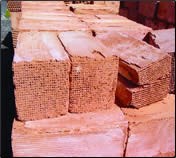Particles are the Enemy
Knowing inputs helps you maintain RTO performance
Regenerative thermal oxidizers (RTOs) are widely used to control volatile organic compounds (VOCs) emitted by painting operations, and most installations can operate trouble-free for extended periods. In some cases, however, operation has been troublesome.
The key to understanding the difference is understanding system inputs, according to RTO supplier Geoenergy Div., A.H. Lundberg Associates Inc. (Bellevue, WA). Inputs include fuel, the VOC-laden gas stream and particulate. There is always some particulate matter in an emission stream; the quantity may be negligible, but it is always present, the company says.
The first two inputs are not much of a factor, according to Geoenergy, but particulates are another matter. Particles in the gas stream are the biggest threat to good RTO operation because they can lead to bed fouling and degradation and possibly to fires.
Coarse particles—greater than five μm in diameter—typically impact on the cold face of an RTO media bed and cause plugging. Left unabated, this buildup can become a fire hazard.
Fine particles—those less than one μm in diameter—are almost exclusively caused when a vapor cools and condenses into a particle, which can be either solid or liquid depending on its chemical composition. Particles in this size range appear as the familiar blue haze that is often seen coming out of biomass dryers, and can be chemically inert or reactive. Inert particles, such as silicon dioxide that results from burning of silane- or chlorosilane-containing waste streams, may plug RTO heat exchanger media.
Chemically reactive fine particles also cause plugging, but they also tend to attack the heat exchange medium, according to Geoenergy. Sodium and potassium oxides, for example, can react with ceramic media at high temperatures to cause embrittlement, crumbling and bed plugging.
The company says the most important part of an RTO design effort in applications with significant amounts of particulate matter is first recognizing the threat and then characterizing the type and concentration of the particulates. The following are some general guidelines for dealing with different particulate types.
A low-efficiency upstream collector, such as low-energy wet scrubbers or properly designed cyclones, can greatly reduce or eliminate coarse particulates. An alternative heat exchange medium with an open cell structure at the bottom of the media bed can also be used to allow the particulate to penetrate deep into the bed where it will burn.
Fine particulates, whether inert or reactive, present a more difficult problem, Geoenergy says. Because of their fine size, removing these particles requires fabric filtration, electrostatic precipitation or high-energy wet scrubbing. The choice depends on the nature of the gas stream.
According to the company, use of a chemical-resistant medium such as a high-alumina material may be appropriate for reactive fines, although even the most expensive ceramics may have limited life if the particulate loading is too high. If fines are condensible, heating the gas stream to revolatilize the condensibles so that they enter the RTO as a vapor can also control the problem. Condensible fines that leave a residue on the RTO cold face as they evaporate may require a bake-out protocol for elimination.
Related Content
Products Finishing Reveals 2024 Qualifying Top Shops
PF reveals the qualifying shops in its annual Top Shops Benchmarking Survey — a program designed to offer shops insights into their overall performance in the industry.
Read MoreMasking Solutions Provider CFS Dramatically Expands Capabilities and Capacity
Custom Fabrication & Supplies (CFS) completed a new plant expansion packing 10 times the capacity into twice the space. It dramatically enhances the supplier’s custom capabilities to provide extremely precise and cost-effective masking solutions.
Read MoreCobot Enters Paint Industry With Safety at the Forefront
This collaborative robot is the first explosion-proof solution for the powder coating and paint arena that meets the U.S.’ stringent safety requirements. Its lead-through teach programming and tablet control are especially appealing to small shops with little proficiency in robotics.
Read MoreConcrete Reinforced Bars Built to Last
Not all corrosion-resistant materials for infrastructure are created equally. Epoxy-coated steel rebar has advantages that other materials used to prevent corrosion do not.
Read MoreRead Next
A ‘Clean’ Agenda Offers Unique Presentations in Chicago
The 2024 Parts Cleaning Conference, co-located with the International Manufacturing Technology Show, includes presentations by several speakers who are new to the conference and topics that have not been covered in past editions of this event.
Read MoreDelivering Increased Benefits to Greenhouse Films
Baystar's Borstar technology is helping customers deliver better, more reliable production methods to greenhouse agriculture.
Read MoreEpisode 45: An Interview with Chandler Mancuso, MacDermid Envio Solutions
Chandler Mancuso, technical director with MacDermid Envio discusses updating your wastewater treatment system and implementing materials recycling solutions to increase efficiencies, control costs and reduce environmental impact.
Read More



























